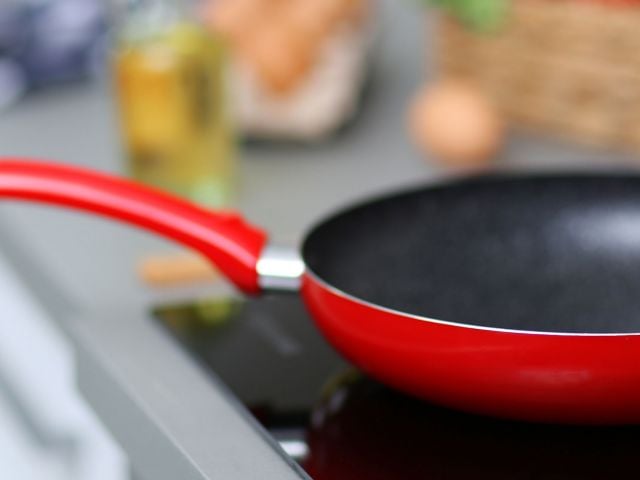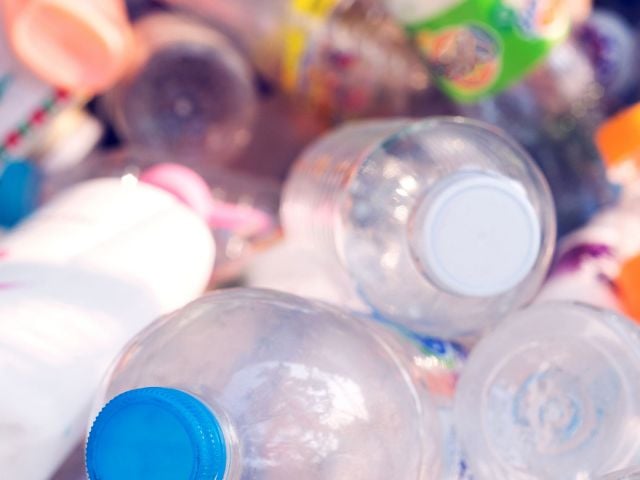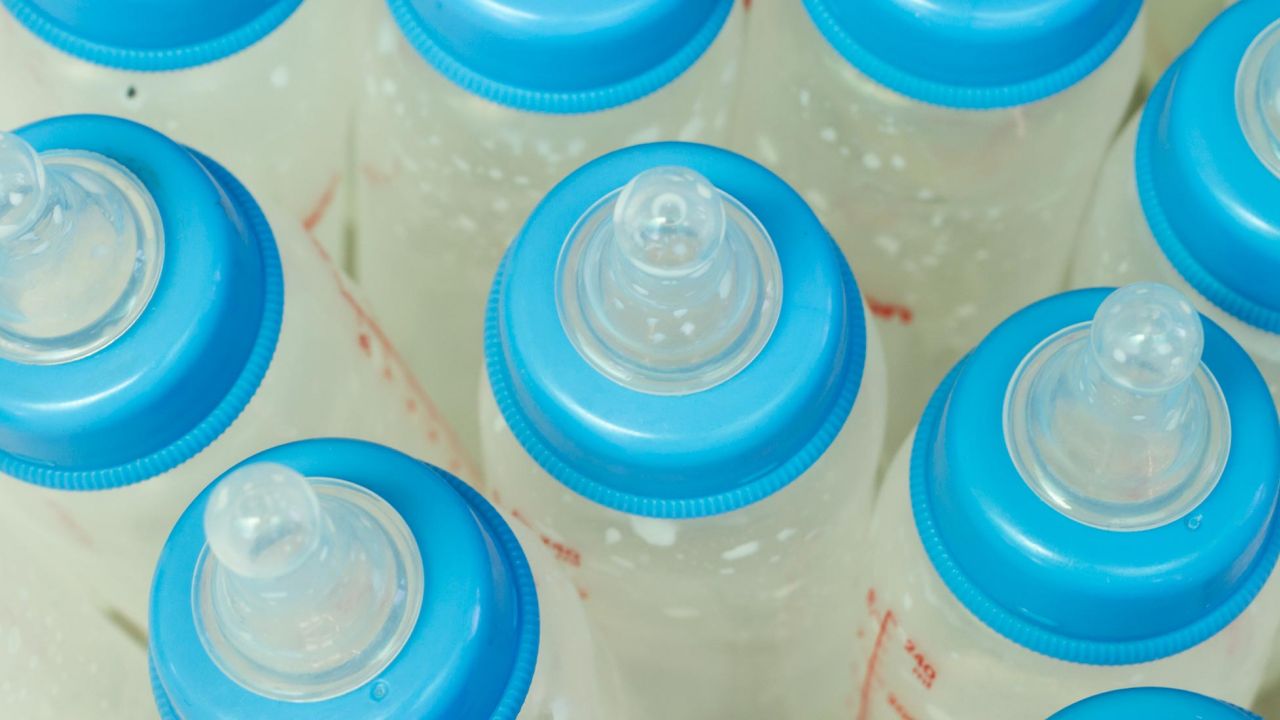
Liquid infant formula from the top manufacturers is sold in cans lined with a toxic chemical linked to reproductive disorders and neurobehavioral problems in laboratory animals, according to an investigation by Environmental Working Group (EWG). The chemical is almost as common in the packaging of powdered formula, with 4 of the top 5 companies acknowledging its use.
![]() The chemical is bisphenol A, or BPA, a component of the plastic epoxy resins used to line metal food cans. Dozens of laboratory studies show that BPA affects the developing brain and reproductive systems of animals exposed to low doses during pregnancy and early life. BPA has recently raised concerns from 2 separate expert panels of the National Institutes of Health (NIH), with 1 group of scientists warning that human exposures to BPA are already at or above the levels that harm animals and another expressing concern about impacts of BPA on infants' brains and behavior.
The chemical is bisphenol A, or BPA, a component of the plastic epoxy resins used to line metal food cans. Dozens of laboratory studies show that BPA affects the developing brain and reproductive systems of animals exposed to low doses during pregnancy and early life. BPA has recently raised concerns from 2 separate expert panels of the National Institutes of Health (NIH), with 1 group of scientists warning that human exposures to BPA are already at or above the levels that harm animals and another expressing concern about impacts of BPA on infants' brains and behavior.
In October and November 2007, Environmental Working Group surveyed the 5 leading makers of baby formula sold in the U.S. to determine whether they use BPA in their packaging. We found:
- The makers of Nestlé, Similac, Enfamil and PBM (who make store-brand formulas sold at WalMart, Target, Kroger and dozens of other retailers) all said that they use BPA in the linings of metal cans holding liquid formula.
- BPA is widely used in powdered formula containers as well. Every manufacturer except Nestlé said it uses a BPA-based lining on the metal portions of their powdered formula cans. Nestlé failed to provide EWG with reliable documentation of their alternative packaging, and thus is not a clear improvement over other types.
- Powdered formulas are a better choice. Our calculations indicate that babies fed reconstituted powdered formula likely receive 8 to 20 times less BPA than those fed liquid formula from a metal can.
Liquid formula is of greatest concern, and its use could lead to high BPA exposures for babies. Recent studies documenting that BPA leaches out of plastic baby bottles prompted a run on glass bottles by concerned parents. But testing by EWG and by the Food and Drug Administration (FDA) indicates that under normal use, liquid formula itself could expose an infant to substantially more BPA than a plastic bottle. <See the graphic> An August 2007 investigation by EWG estimated that at BPA levels found in ready-to-eat liquid formula, 1 of every 16 infants fed the formula would be exposed to the chemical at doses exceeding those that caused harm in laboratory studies.
The safest choice is clear: Breastfeed your baby whenever possible.
Breast milk is the best source of nutrition for babies. It contains essential fatty acids that help bolster babies’ bodies against the impacts of toxic chemicals. However, there are many reasons why families rely on formula for some or all of their baby’s diet. Seventy percent of babies in the U.S. receive some formula by the time they are 3 months old. These babies need a safe and healthy source of food, and formula should be manufactured in a way that avoids contamination with harmful chemicals.
If your child is fed infant formula, you can reduce BPA exposure by choosing powdered formula.
Nestlé, makers of Good Start and Mam brands, repeatedly told EWG researchers that its powdered formula cans contain no BPA. Nestlé's emails to parents repeat this claim, but the company has failed to document this in writing or provide information on their alternative to EWG, despite our numerous requests to the company. In any case, EWG cannot recommend Nestlé baby formula due to the company's long history of ethically suspect infant formula marketing practices in the developing world. Nestlé's claim that it uses BPA-free packaging, if true, would be welcome news, because it suggests that other manufacturers could switch to safer packaging materials and reduce babies' BPA exposures. Powdered formula sold by Enfamil and Similac are reduced-risk choices, because only the metal tops and bottoms of their packages – not the cardboard sides – are metal and lined with BPA-based plastic. Earth's Best Organic and PBM (which make dozens of store brands) are more of a concern: they are sold in an entirely metal can, which means the formula has more contact with a BPA-coated surface.
If you must choose liquid formula, look for types sold in plastic containers or purchase concentrated – not ready-to-eat – types.
If you buy liquid formulas, look for those sold in plastic containers. If you must use liquid formula sold in metal cans, choose concentrated rather than ready-to-eat formula. Both FDA and EWG have tested samples of liquid formula sold in cans and found BPA in every company’s formula. Choosing a formula that requires dilution with water reduces the amount of BPA in your baby’s diet.
If you don’t know whether your brand is packaged with BPA, ask – and demand a straight answer.
During our initial calls to formula manufacturers, we asked company representatives if their packaging contains BPA, if they test for BPA levels in their products, and if they would disclose their test results to EWG. Many of the companies had a prepared response – “We comply with all FDA regulations regarding BPA and formula” – so it was clear that concerned parents are asking about BPA in formula. We later sent an email, without mentioning EWG, to see whether the information they gave to parents was consistent with what they told us. PBM, the manufacturer of store brands, told EWG researchers their containers have a BPA lining. However, PBM later sent an EWG staff member an email stating that their packaging contains no BPA. These conflicting claims raise serious doubts about the credibility of PBM’s consumer information on BPA. Nestlé tells parents on the phone and by email that their powdered formulas have no contact with BPA. They repeatedly told EWG researchers the same thing over the phone, but failed to put their claims in writing, making it difficult to determine if Nestlé is really a better option for babies. Ross-Abbot, the makers of Similac, is the only company that told us they tested for BPA in their products, and that they detected none. However, both EWG and the Food and Drug Administration have found BPA in Similac cans, raising questions about either Ross-Abbot’s candor or the sensitivity of their testing methods.
Safe Baby Bottle and Formula Guide
Breast milk is best, but whether you’re feeding breastmilk or formula in a bottle, use this guide to feed your baby safely. Read more about babies' exposures to BPA in formula
Nipple: Start with a clear silicone nipple.
Latex rubber nipples can cause allergic reactions and can contain impurities linked to cancer.
Bottle: Use glass.
Plastic bottles can leach a toxic chemical called bisphenol A (BPA) into formula and breast milk. Avoid clear, hard plastic bottles marked with a 7 or “PC.”
Plastic bottle liners: Don’t use them.
The soft plastic liners may leach chemicals into formula and breast milk, especially when heated.
Water: Use filtered tap water.
If your water is fluoridated, use a reverse osmosis filter to remove fluoride, which the American Dental Association recommends avoiding when reconstituting formula. If your water is not fluoridated use a carbon filter. If you choose bottled water make sure it’s fluoride-free.
Formula: Choose powdered.
A toxic chemical called bisphenol A (BPA) can leach into liquid formula sold in metal cans. Canadian tests show no BPA leaching into powdered formula. The same brands are sold in the U.S., making powdered formula a low-risk for BPA contamination. If you're concerned about BPA click here to tell infant formula manufacturers to remove it from their product packaging.
FORMULA BUYING GUIDE
Choose powdered formula when possible, or liquid formula in glass or plastic containers.
Avoid all liquid formula in metal cans.
Heating: Warm bottles in a pan of hot water.
Microwaving can heat unevenly and cause chemicals to leach from plastic bottles into formula.
Details
More details for bottle-feeding parents:
Breastfeed whenever possible!
Breast milk is the best source of nutrition for babies, and contains essential fatty acids that help bolster babies' bodies against the impacts of toxic chemicals. However, there are many reasons why families rely on formula for some or all of their baby’s diet. Most babies in the US receive some formula during their first year of life, with 70 percent of babies receiving some formula by 3 months of age (CDC 2007). These babies need a safe and healthy source of food, and formula should be manufactured in a way that avoids contamination with hormone disrupting chemicals.
Formula-feeding
Powdered formulas are the best choice for parents who want to avoid bisphenol A in their baby's diet. While powdered formula has not been tested for BPA, it is diluted with much more water than liquid formulas which reduces the amount of BPA that the baby consumes in each feeding. Nestlé has made unsubstantiated claims that they don't use any BPA to line their powdered formula cans. Nestlé, Enfamil and Similac use a mixed metal and cardboard package with less BPA-coating. Second best are Earth's Best Organic and PBM's store-brand powdered formulas that use a fully metal can.
Some liquid formulas are sold in plastic, mostly polyethylene and polypropylene which do not contain any BPA. Avoid any plastic containers that are rigid and transparent, marked with "PC". All liquid formulas sold in metal cans are lined with BPA-epoxy, which has been shown to leach into the product. If you buy formula in metal cans choose the concentrated type which is diluted with water prior to feeding. Avoid ready-to-eat formula in metal cans, which has the highest BPA leaching potential.
Bottle Nipples
Choose bottle nipples made from silicon. They are the most durable and inert options. Latex rubber nipples can cause allergic reactions and can contain impurities linked to cancer (Freishtat 2002; Westin 1990). The same goes for pacifiers. Throw away any nipple or pacifier that is discolored, thinning, tacky or ripped.
Bottles
There has been a lot of attention recently about BPA leaching from baby bottles and sippy cups. It appears, however, that babies fed liquid formula could have much more intense exposure to BPA from the formula itself. Even so, parents should still choose bottles that don't leach any BPA. Glass bottles are an excellent choice. More manufacturers are also making bottles and sippy cups out of safe plastics which are polyethylene, polypropylene or polyamide. Avoid all polycarbonate which are transparent (either clear or tinted) and rigid or inflexible plastic. These bottles may be marked with the letters “PC.” Polycarbonate plastics are sometimes marked with the recycling #7, which is a miscellaneous category, so not all #7 plastics are harmful.
Your pediatrician may recommend plastic bottle liners if your baby is colicky. If not, avoid using them - the manufacture and disposal of plastic liners raise environmental concerns. And never overheat formula in a plastic liner. The soft plastic liners may leach chemicals into formula, especially when heated.
What type of water?
If your water is fluoridated, use a reverse osmosis (RO) filter to remove fluoride, which the American Dental Association recommends avoiding when reconstituting formula (ADA 2006). If your water is not fluoridated, use a carbon filter, either a pitcher-style or one that attaches to your tap. If you choose bottled water make sure it's fluoride-free. Be aware that the cost of bottled water may add up to more money than a home reverse osmosis system.
Expressing breast milk
Medela breast pump tubes, shields, and jars are BPA and phthalate free. This is important as pump parts withstand repeated washings in hot water.
Cleaning and sterilizing
Bottles, nipples, pacifiers, breast shields, pump tubing and containers should be sterilized before first use. After that, washing with hot soapy water or the top shelf of the dishwasher should be sufficient. Avoid sterilizing in the microwave or frequent use of boiling water since both will speed the breakdown of the plastic.
Warming a bottle
Warm bottles of formula or breast milk in a bowl of hot water. Do not microwave them or place them in boiling water. In addition to creating a hazard for baby, these extreme heats weather the plastics.
Powdered is better
Update: In August 2008 scientists from Canada's Food Research Division reported finding no BPA in powdered formula sold in Canada. The Canadian results support EWG's recommendation that powdered formula is a safer choice for formula-fed babies. Find answers to frequently-asked questions about BPA in formula and bottles here.
BPA has been detected in every brand of liquid formula, but powdered formulas have not yet been tested. While most formula containers produced in the United States contain some BPA in the lining, we found significant differences in BPA leaching potential of liquid and powdered formulas. Our modeling suggests that powdered formulas are a better choice for babies. We modeled three factors that determine BPA leaching potential from different types of formula containers and concluded that liquid formulas have 8 to 20 times higher potential BPA leaching than the most common powdered formulas due to smaller can sizes and the fact that the product is less diluted with water.
Even if the same amount of BPA leached from coated metals in powdered and liquid formulas, babies fed powdered formula will receive less BPA than those fed liquid formula from metal cans
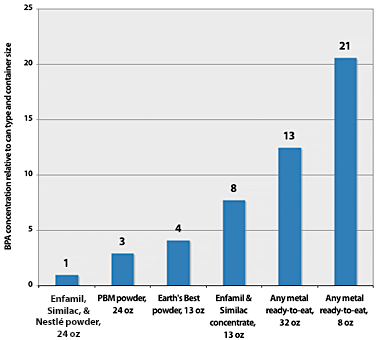
Four factors govern the amount of BPA leaching from different types of formula in metal cans:
- The amount of surface area coated with BPA. Enfamil and Similac use BPA on the metal top and bottom lids of their package, approximately 30% of the container. Earth’s Best Organic, PBM/Store Brands and all liquid formula use cans with 100% BPA lining. Nestlé claims to use no BPA in their packaging but it is unclear what they use instead.
- The volume of the container. Smaller containers have a higher surface-to-volume ratio which results in potentially higher concentrations of BPA in the product than larger containers.
- How much the product is diluted with water. For powdered formula, parents mix about 34 grams of powdered formula with 8 ounces (226 grams) of water, meaning about 13% of the bottle contents came from the can. For concentrated liquid formula, parents mix with an equal amount of water, diluting the contents of the can by 50%. Ready-to-eat formulas are not diluted with any water.
- The heat intensity of the canning process. Studies measuring BPA levels in liquid formula find that the actual amount of BPA is variable, probably due to differences in the can and the processing. Since there is no available information on the BPA content of powdered formulas, we assumed that BPA is equally likely to leach from the plastic surfaces of a powdered or liquid formula can.
Our calculations also assume that parents are using bottles that don't leach any BPA into formula. Using Enfamil and Similac cans with 30% BPA coating as the baseline we found that 100% metal cans of powdered formula (used by Earth's Best and PBM) have 3 or 4 times higher leaching potential depending on the can size. But the real difference is comparing the leaching potential of liquid and powdered formulas. The maximum leaching potential was from ready-to-eat formula in smaller 8 oz. cans. These types have the highest BPA contact per unit surface area and are not diluted with any water prior to feeding. These formulas have an estimated 21-times more BPA leaching than the most popular types of powdered formulas. Provided that BPA leaches equally from liquid and powdered formulas during processing, powdered formulas are a better option for babies. Parents should also be advised to buy formula in the largest size available and to choose concentrated rather than ready-to-eat liquid formulas.
| Type of formula and container | Brands | Typical container size | BPA coated surfaces | Amount of formula once diluted with water | Relative BPA leaching potential |
| Powdered, cardboard-metal can | Similac, Enfamil | 24 oz | 30% | 13% | 1∗∗ |
| Powdered, full metal can | PBM | 25 oz | 100% | 13% | 3 |
| Powdered, full metal can | Earth’s Best | 13 oz | 100% | 13% | 4 |
| Liquid concentrated | Various | 13 oz | 100% | 50% | 8 |
| Liquid ready-to-eat, large can | Various | 33 oz | 100% | Not diluted | 13 |
| Liquid ready-to-eat, small can | Various | 8 oz | 100% | Not diluted | 21 |
∗∗This formula was used as a baseline when comparing the potential BPA leaching from other types
Take action!
Tell Your Formula Company to Remove BPA
Formula Company Contact Info
Click the email address of your formula company below, scroll down to the bottom of the list, and copy and paste the Sample Email (remember to add your name!). Also use the Sample Email for companies with online forms instead of email addresses.
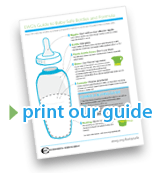 Baby Basics / Bright Beginnings / Parent’s Choice and other store brands (Target, Kroger, Albertsons, Safeway)
Baby Basics / Bright Beginnings / Parent’s Choice and other store brands (Target, Kroger, Albertsons, Safeway)
[email protected]
Earth's Best
[email protected]
Enfamil
[email protected]
Isomil (online form only)
http://rpdmail.com/?site=WAC_CU
Nestle Good Start or Mam (online form only)
http://www.verybestbaby.com/Public/ContactUs.aspx
ProSobee
[email protected]
Safeway
[email protected]
Similac (online form only)
http://rpdmail.com/?site=WAC_CU
Don't see your generic or store brand? Contact Bright Beginnings, the company that produces many generic and stores brands.
[email protected]
Sample Email
I recently learned that your company uses a hormone-disrupting chemical called bisphenol A (BPA) as a lining for the metal portions of your baby formulas. Environmental Working Group and FDA tests show that the chemical leaches into the formula and could subject babies to harmful exposures. In fact, EWG calculated that 1 in 16 children fed ready-to-eat formula from steel cans would have BPA exposures that exceed doses found harmful in animal studies.
Two separate panels sponsored by the National Institutes of Health (NIH) have expressed concerns about infant exposure to BPA. The Center for the Evaluation of Risks to Human Reproduction (CERHR) concluded that infant exposure could harm brain development and adversely affect behavior. The chairman of the CERHR panel indicted that “it might be a time for application of the precautionary principle” for BPA, suggesting that parents would be wise to avoid infant exposure to the chemical until serious outstanding questions about BPA’s potential harm are sorted out.
The second NIH panel of 38 BPA experts expressed grave concerns that human exposures are at or above the levels that cause harm in animal studies.
As a consumer of your product and concerned parent I want to know if your formula is contaminated with BPA, and at what levels. I urge you to provide consumers with infant formulas that are free of this toxic chemical.
Sincerely,
BPA in baby bottles
There has been justifiable concern recently about BPA leaching from baby bottles into the baby’s formula. The available data indicate, however, that liquid formulas may be a more potent source of infant exposure to BPA.
BPA has been detected in 16 of 20 liquid formula samples tested by FDA and EWG. Concentrations range from less than 1 part per billion (ppb) to 17 ppb in these samples, with an average of 5 ppb (EWG 2007a; Biles 1997). Although the data from the FDA are now 10 years old, EWG found no information indicating that formula containers has changed significantly since then, and our recent testing finds quite similar results.
Baby bottles have been more extensively tested. We found 11 studies testing BPA leaching out of polycarbonate baby bottles, reviewed by the EU Food Safety Authority or NIH review panel (EFSA 2006; CERHR 2007b) and 1 test from an advocacy group (Environment California 2007). Baby bottle tests were often designed to measure the amount of BPA that leaches out over many washing cycles. As a result, most use water heated to 100 to 200 degrees, much hotter than any liquid fed to real babies. Thus the concentrations of BPA measured reflect aggregate exposures over time, not the amount of BPA that would be released in a typical feeding.
Three tests using water between 78 and 104 degrees found no detectable BPA in bottles. Nine tests using 122 to 212 degree water found varying amounts of BPA. Of these half measured BPA levels lower than the concentrations in liquid formula, and half had higher BPA. However, since these tests reflect BPA leaching out of bottles over many wash cycles and not necessarily in liquids fed to babies, we conclude that liquid formulas present a more direct risk of BPA exposure.
BPA leaching from baby bottles filled with 78 to 176 degree water is less intense than everyday exposures from liquid formula
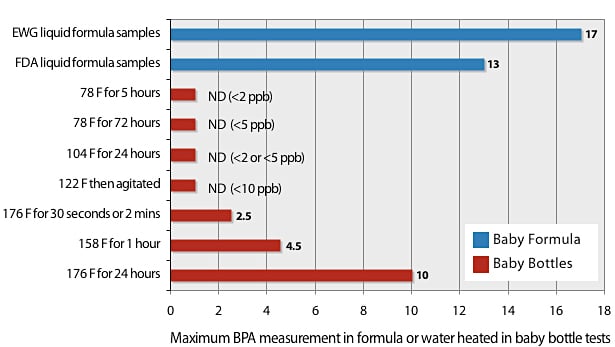
| Test Conditions | BPA concentration in tested liquids | Source |
| Liquid baby formula in metal cans | ||
| 6 liquid formula samples | Avg 5.3 ppb, max 17 ppb | EWG 2007a |
| 14 liquid formula samples | Avg 5 ppb, max 13 ppb | FDA 1997 |
| Bottle tests at 78 to 176 degrees | ||
| 78 F for 5 hours | ND (<2 ppb) | Hanai 1997 |
| 78 F for 72 hours | ND (<5 ppb) | FDA 1996 |
| 104 F for 24 hours | ND (<2 to 5 ppb) | FCPSA 2005 |
| 122 F | ND (<10 ppb) in water or vinegar, high levels in bottles 95% ethanol. | Simouneau 2000 |
| 158 F for 1 hour, water and acetic acid | ND (<1) to 5.1 ppb | CSL 2004 |
| 176 F for 30 seconds or 2 mins | 1.1-2.5 ppb | D'Antuono 2001 |
| 176 F for 24 hours | 4 to 10 ppb, avg 7 ppb | Environment California 2007 |
| Bottles tested with >200 degree water | ||
| 203 F for 30 mins | ND (<0.5) to 0.75 ppb | Sun 2000 |
| 203 F for 30 mins | ND (<0.05) to 3.9 ppb | Miyamoto 2006 |
| 212 F for 30 mins, then held 72 hours | ND (<5 ppb) | FDA 1996 |
| 212 F for 1 hour | 0.11 to 17 ppb, Avg 7 ppb in bottles washed 50+ times prior to test | Brede 2003 |
| 212 F then cool | 3 to 55 ppb | Hanai 1997 |
| 212 F then cool, reheat to 40 C | ND (<10) to 50 ppb | Earls 2000 |
ND = not detected, value in parentheses is the detection limit.
BPA in formula--how harmful?
Each company we contacted was quick to point out that it complies with all relevant health guidelines regarding formula packaging. It’s true. Unfortunately, the standards and guidelines of the FDA and the Environmental Protection Agency are outdated and inadequate in light of growing scientific concerns about the potential harm to infants from BPA exposure.
This year, 2 separate panels from the National Institutes of Health (NIH) have expressed concerns about infant exposure to BPA. The Center for the Evaluation of Risks to Human Reproduction (CERHR) concluded that there was “some concern” that infant exposure could harm brain development and adversely affect behavior (CERHR 2007b). The chairman of the CERHR panel indicated that “it might be a time for application of the precautionary principle” for BPA, suggesting that parents would be wise to avoid all infant exposure to the chemical until serious outstanding questions about BPA’s potential harm are sorted out (Hileman 2007).
More grave concerns were expressed by a BPA expert committee convened by the National Institute of Environmental Health Sciences, a division of NIH. A consensus statement prepared by the committee concluded that the majority of current human exposures are at or above the levels that cause harm in repeated animal studies (vom Saal 2007).
Very little is known about BPA concentrations in infant formula. EWG and FDA have both tested liquid formulas. EWG tested 6 and FDA tested 14 samples (Biles 1997, EWG 2007a). Both studies found on average 5 parts per billion of BPA, and 4 samples with more than 10 ppb. At these concentrations, lighter and hungrier babies will exceed the daily doses of BPA that have been found harmful by the most sensitive laboratory studies. Most other children have an unacceptably low margin of safety between their daily exposures and the doses that are harmful in the laboratory. Because it is very likely that some people are more sensitive to BPA, or less efficient at eliminating it from their systems, it is vital that tougher regulations are put into place to reduce BPA exposures to levels many times below those found harmful in the lab.
Powdered formula samples in the U.S. have not been tested for BPA leaching. One study in Taiwan examined BPA in three powdered soy formula samples and four ‘follow-up’ formulas which are intended for older children (Kuo 2004). They detected BPA in every sample, at concentrations higher than those found in liquid formulas tested in the United States. Tests of U.S. powdered formulas are sorely needed.
Dozens of recent studies link very low concentrations of BPA with permanent alterations of the reproductive system, brain and behavior of laboratory animals (Maffini 2006). However, FDA regulations governing BPA leaching from food containers are completely out of touch with these findings of low dose toxicity. Regulations mandate that leaching of BPA into food must not exceed 0.05 milligrams of BPA from each square inch of the can surface (FDA 2006). At the maximum allowable BPA leaching, this would result in 0.5 to 5 parts per million of BPA in standard size formula cans, and lead an average 0 to 4 month old baby to exceed EPA’s outdated safe daily dose of BPA by up to 30 times (EPA 1998).
How much is safe?
Every manufacturer we contacted also assured us that there is no evidence that babies fed from BPA lined food cans and polycarbonate bottles are harmed. This also is true because no one has looked for these effects and because the potential health impacts of BPA exposure would occur later in life, and would not likely be traced back to BPA exposures during pregnancy and early life. BPA’s impacts include insulin resistance, brain and behavioral impacts, early puberty, altered hormone levels, and other reproductive problems--conditions that occur years or decades after babies are weaned from formula.
The very low concentrations of BPA found in formula put babies at unacceptable risks of harm to their brain and nervous system, and reproductive systems. Exposure to BPA in animal studies has been linked to a number of adverse health effects at incredibly low doses. The most sensitive studies find oral BPA exposures to lab animals of about 2 micrograms per kilogram of body weight per day caused increased prostate weight in animals exposed during pregnancy, (Nagel 1997), increased aggression at eight weeks of life (Kawai 2003), signs of early puberty (Howdeshell 1999), lower body weight (Honma 2002), decline in testicular testosterone (Akingbemi 2004), and cause breast cells to be predisposed to cancer in later life (Murray 2007).
Laboratory studies consistently show that the most sensitive periods of exposure to BPA are during pregnancy and early life (Maffini 2006). BPA has also been found in American mothers’ breast milk, amniotic fluid, and cord blood, indicating widespread exposure before birth (CERHR 2007b). A recent finding by the Centers for Disease Control found detectable BPA in more than 90% of 2,500 people sampled (Calafat 2007). The study didn’t include any children younger than 6, so much less is known about current exposures for newborns and babies.
EWG’s modeling, using real-life formula sampling and a survey of baby weight and formula intake, found that one of every 16 infants exclusively fed ready-to-eat canned formula would be exposed to BPA at doses exceeding those that altered testosterone levels, affected neurodevelopment, and caused other permanent harm to male and female reproductive systems (EWG 2007b). At the highest BPA levels found in formula, 17 parts per billion (ppb), nearly 2/3rds of all infants fed ready-to-eat formula would be exposed above doses that proved harmful in animal tests (EWG 2007b).
Earlier this year, the National Institutes of Health’s Center for the Evaluation of Risks to Human Reproduction (CERHR) program led an assessment of the safety of BPA. It was a highly contentious process. During the review NIH fired the CERHR contractor, Sciences International, for potential conflicts of interest including their contracts to work for companies who manufacture BPA (Bucher 2007). The draft scientific review document considered by the panel was riddled with hundreds of errors and omissions and received sharp criticism from BPA researchers (CERHR 2006). The CERHR panel dismissed evidence that BPA impacted breast and prostate development, and linking the chemical to infertility and early puberty. Nevertheless the panel did find that there was "some concern" for BPA's impact to brain and behavior for infants and children (CERHR 2007b). In the meantime, an alternative group of 38 BPA researchers and experts published a parallel review with conclusions that diverged sharply from CERHR, determining that that BPA presents a clear risk to human health (vom Saal 2007).
Much of the controversy arises over the interpretation of dozens of studies showing BPA affecting the reproductive problems and cancer at low doses. Several reviews have dismissed studies showing low-dose toxicity (EFSA 2006; CERHR 2007b). However the 38 BPA experts came to a different conclusion:
“Importantly, much evidence suggests that these adverse effects are occurring in animals within the range of exposure to BPA of the typical human living in a developed country, where virtually everyone is exposed to measurable blood, tissue and urine levels of BPA that exceed the levels produced by doses used in the low dose animal experiments" (vom Saal 2007).
Study methods & findings
On July 31, 2007, EWG sent letters to every major formula manufacturer to inquire about their use of BPA in formula packaging and product testing. The only company who responded makes a toddler formula, intended for children older than 1 year, none of the infant formula makers responded. In October we launched a formal inquiry into the use of BPA in formula. EWG staff contacted the 4 major formula producers--Enfamil, Nestlé, Similac and PBM--as well as the leading manufacturer of organic formula Earth’s Best Organic. We contacted each company a minimum of 3 times, and asked company representatives a series of questions about BPA: 1) whether BPA was used in liquid and powdered formula containers; 2) whether the company had performed any analysis of BPA leaching into formula; 3) what their testing found; and 4) whether they would disclose test results to EWG. Contacts included at least 2 phone calls in which we documented all responses and at least 1 email inquiry to confirm that the information they provided parents was in synch with the information they provided environmental researchers. We found that all liquid formulas in metal cans are lined with a BPA-based plastic epoxy. Most powdered formulas contain some BPA-based lining, but the content ranges from 30 to 100% of the can surface.
Here are the company's answers to our interviewer's questions:
- Nestlé (Good Start and Mam)
- Ross-Abbot (Similac, Isomilk, Alimentum, NeoSure)
- MeadJohnson (Enfamil, ProSobee, Latofree, and Nutramigen)
- Earth's Best Organic
- Store Brand formulas (Baby Basics, Bright Beginnings, Parent's Choice and others)
Nestlé uses a BPA-based plastic to line metal cans that hold liquid formula. They claim not to use any BPA in their powdered formula containers which, if true, would make them the only manufacturer to sell a baby formula with no risk of BPA-leaching. However, they would not provide EWG with a written statement to support this claim. Also, questions on the company’s ethical practices cause EWG to have concerns about recommending their product.
| Company | Nestlé |
| Brands | Good Start, Mam |
| Dates contacted | 9/21/07 9:38 a.m. (PDT), 10/4/07 11:15 a.m., 10/18/07 10:00 a.m. (EDT) |
| Phone number | 1/800 284-9488 |
| Company representative(s) |
Name(s) withheld for privacy |
| BPA in cans of liquid formula? | Yes, liquid formulas sold in metal cans. |
| BPA in packages of powder formula? | No |
| Test for BPA? | No |
| Disclose results? | N/A |
| FDA test results for liquid samples? | BPA detected in 3 of 3 samples of liquid formula |
| EWG test results for liquid samples? | None tested |
| Notes | Nestle is the target of an international boycott for using unethical practices to market formula in the developing world (Aguayo 2003). |
Ross-Abbot uses a BPA-based plastic to line metal in their liquid cans and the metal lid and bottom of their powdered containers. They are the only company that reported periodic testing for BPA in their products, and claim that their tests do not detect any leaching. They would not give EWG test results or a description of their test methods. Both EWG and FDA tests have detect BPA in their liquid formulas which gives reason to question Ross-Abbot’s testing methods.
| Company | Ross-Abbot |
| Brands | Similac, Isomil, Alimentum, NeoSure |
| Dates contacted | 9/20/07 12:15 p.m. (PDT), 10/03/07, 4:24 p.m. (EDT) |
| Phone number | 1/800-227-5767 |
| Company representative(s) |
Name(s) withheld for privacy |
| BPA in cans of liquid formula? | Yes, liquid formulas sold in metal cans. |
| BPA in packages of powder formula? | Yes, top and bottom lid of powdered containers |
| Test for BPA? | Yes, "periodic testing detects no BPA" |
| Disclose results? | Would not disclose test results to EWG. |
| FDA test results for liquid samples? | BPA detected in 4 of 4 samples of liquid formula |
| EWG test results for liquid samples? | BPA detected in 1 of 3 tests of liquid formula |
| Notes | Given that FDA & EWG tests found BPA in cans of Similac, Ross-Abbot’s testing techniques may not be sensitive enough. Ross-Abbot also sells concentrated liquid formula in plastic containers that contain no BPA. |
MeadJohnson uses a BPA-based plastic in their liquid formula packaging and in the top and bottom lids of their powdered formula containers. They do not perform tests to detect BPA in their products.
| Company | MeadJohnson |
| Brands | Enfamil, Lactofree, Nutramigen, ProSobee |
| Dates contacted | 9/20/07 12:30 p.m. (PDT) 10/03/07, 4:45 p.m. (EDT) |
| Phone number | 1/800-222-9123 |
| Company representative(s) |
Name(s) withheld for privacy |
| BPA in cans of liquid formula? | Yes, liquid formulas sold in metal cans. Also used to line the lids of glass or plastic bottles. |
| BPA in packages of powder formula? | Yes, top and bottom lid of powdered containers |
| Test for BPA? | No |
| Disclose results? | N/A |
| FDA test results for liquid samples? | BPA detected in 3 of 3 cans of liquid formula |
| EWG test results for liquid samples? | BPA detected in 1 of 3 cans of liquid formula |
Hain-Celestial only sells powdered formula in a fully metal can, which uses a BPA-based plastic in the entire can lining. They do not test their product for BPA leaching.
| Company | Hain-Celestial |
| Brands | Earth’s Best Organic |
| Dates contacted | 9/20/07 12:50pm (PDT), multiple email attempts |
| Phone number | 1/800-434-4246 |
| Company representative(s) |
Name(s) withheld for privacy |
| BPA in cans of liquid formula? | NA. The company sells only powdered formula |
| BPA in packages of powder formula? | Yes |
| Test for BPA? | No |
| Disclose results? | N/A |
| FDA test results for liquid samples? | N/A |
| EWG test results for liquid samples? | N/A |
| Notes | No one has tested Earth's Best formulas or any other powdered formulas sold in the U.S. for BPA |
PBM manufactures infant formula for store brands and private labels. They uses a BPA-based lining on their metal cans for liquid and powder formula. EWG received copies of 2 emails PBM sent parents claiming that their product is BPA-free.
| Company | PBM, maker of store brand formulas |
| Brands | Baby Basics, Babymil, Bright Beginnings, Comforts, CVS, Eckerd, Good Sense, Hill Country Fare, Home Best, Kozy Kids, Little Ones, Meijer, Nanny’s, Parent’s Choice, Perfect Choice, Shop Rite, Target, Top Care, Walgreens, Wegmans, Western Family. |
| Dates contacted | 10/05/07, 4:00 p.m., 10/10/07 1:10 p.m., 10/12/07 1:20 p.m., 10/12/07 4:20 p.m. (EDT) |
| Phone number | 1/800-272-5095 |
| Company representative(s) |
Name(s) withheld for privacy |
| BPA in cans of liquid formula? | Yes, liquid formulas sold in metal cans. |
| BPA in packages of powder formula? | Yes |
| Test for BPA? | No |
| Disclose results? | N/A |
| FDA test results for liquid samples? | BPA detected in 3 of 3 cans of liquid formula |
| EWG test results for liquid samples? | None tested |
| Notes | PBM gave conflicting answers to queries about its use of BPA. They told EWG researchers that their packaging contained BPA, but 2 emails to parents say that the company does not use it. |

